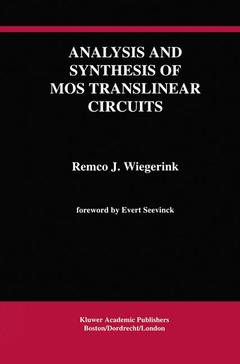Analysis and Synthesis of MOS Translinear Circuits, Softcover reprint of the original 1st ed. 1993 The Springer International Series in Engineering and Computer Science Series, Vol. 246
Langue : Anglais
Auteur : Wiegerink Remco J.

This book has its roots in an idea first formulated by Barrie Gilbert in 1975. He showed how bipolar analog circuits can realize nonlinear and computational functions. This extended the analog art from linear to nonlinear applications, hence the name trans linear circuits. Not only did this new principle enable marvellous signal processing functions to be accurately implemented, but also the circuits were simple and practical. The perennial problems of analog Ie design, namely temperature sensitivity, processing spread, device nonlinearity and paracitic capacitance were solved to a large extent. Using the trans linear principle in circuit design requires changing your point of view in two ways. First, the grossly nonlinear characteristic of transistors is viewed as an asset rather than as a harmful property. Second, no longer are the signals represented by voltages, but by currents. In fact, the attendant voltage changes are distorted but, as they are very small, they are only of secondary interest. Understanding and analyzing a given trans linear circuit is fairly straightforward. But what about the converse situation: suppose you're given some nonlinear or computational function to implement? How to find a suitable translinear circuit realization? The general problem of analog circuit synthesis is a difficult one and is receiving much attention nowadays. Some years ago, I had the opportunity to investigate methods for designing bipolar trans linear circuits. It turned out that translinear networks have some unique topological properties. Using these properties it was possible to establish heuristic synthesis procedures.
1 Introduction.- 1.1 Motivation.- 1.2 Previous work.- 1.3 Outline of this book.- 1.4 References.- 2 The MOS Translinear Principle.- 2.1 Introduction.- 2.2 Derivation of the MTL Principle.- 2.3 Using both N-type and P-type transistors in a single.- translinear loop.- 2.4 Second-order effects.- A. The body-effect.- B. Mobility reduction.- C. Weak inversion.- D. Channel length modulation.- E. Component mismatches.- F. Errors caused by parasitic resistance and capacitance.- G. Temperature dependence.- 2.5 The effect of noise.- 2.6 Dynamic range and distortion.- 2.7 Comparing MOS translinear and bipolar translinear circuits.- 2.8 Conclusions.- 2.9 References.- 3 Analysis of MOS Translinear Circuits.- 3.1 Introduction.- 3.2 TL-graphs.- 3.3 Systematic analysis of MOS translinear networks.- 3.4 Example: rail to rail CMOS input stage with a constant transconductance.- 3.5 Example: vector sum circuit.- 3.6 MTL loops that can be electronically opened.- 3.7 MTL networks consisting of a single translinear loop of four transistors.- 3.8 Simple graphical representation of MTL networks consisting of a single loop and having one input and one output signal.- 3.9 Development of the computer program MTLPLOT for computer aided analysis of MTL networks.- 3.10 Comparing the loop equations of MOS and bipolar translinear loops.- 3.11 Conclusions.- 3.12 References.- 4 Synthesis of MOS Translinear Circuits: A Design Strategy.- 4.1 Introduction.- 4.2 Basic functions realized by MTL circuits.- 4.3 Realization of a function using a suitable combination of basic functions.- 4.4 Example: wideband linear current attenuator with electronically variable gain.- 4.5 Computer aided synthesis of MOS translinear loops.- 4.6 Example: class AB rail-to-rail output stage for CMOS operational amplifiers.- 4.7 Conclusions.- 4.8 References.- 5 Comparison of MOS Translinear Loop Topologies.- 5.1 Introduction.- 5.2 Choosing a suitable loop topology.- 5.3 The stacked loop topology.- 5.4 The up-down loop topology.- 5.5 The electronically simulated loop topology.- 5.4 Conclusions.- 5.5 References.- 6 Application: Fast Four-Quadrant Current Multiplier.- 6.1 Introduction.- 6.2 Principle of operation.- 6.3 An MTL current squaring circuit.- 6.4 The four-quadrant current multiplier.- 6.5 Second-order effects.- 6.6 Simulated and measured results.- 6.7 Conclusions.- 6.8 References.- 7 Application: Variable-Gamma Circuit for Colour Television.- 7.1 Introduction.- 7.2 The variable gamma system.- 7.3 The variable gamma function block.- 7.4 Computer aided implementation of the inverse hyperbolic sine function.- 7.5 Simulated and measured results.- 7.6 Conclusions.- 7.7 References.- 8 Conclusions.- 8.1 Introduction.- 8.2 Summary.- 8.3 Original contributions of this book.- 8.4 Recommendations for further research.- Appendix A: TL graphs of MTL networks with one or two loops and less than 8 transistors.- Appendix B: MOS translinear loops with 7 or less transistors.- Appendix C: Some MTL network realizations.
Date de parution : 09-2012
Ouvrage de 156 p.
15.5x23.5 cm
Mots-clés :
CMOS; Signal; analog; circuit; computer; electronic circuit; electronics; network; transistor
© 2024 LAVOISIER S.A.S.



